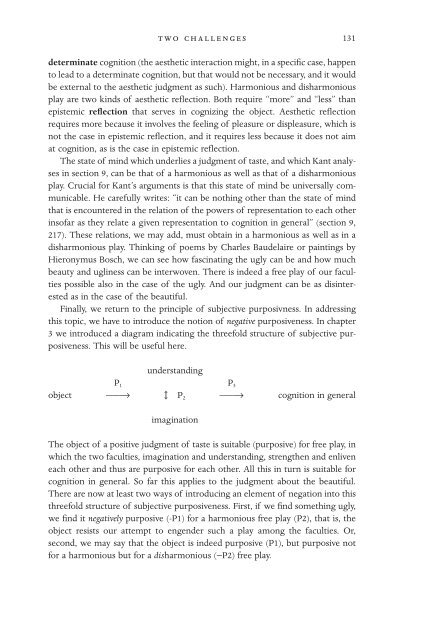AN INTRODUCTION TO KANT'S AESTHETICS
AN INTRODUCTION TO KANT'S AESTHETICS
AN INTRODUCTION TO KANT'S AESTHETICS
Create successful ePaper yourself
Turn your PDF publications into a flip-book with our unique Google optimized e-Paper software.
TWO CHALLENGES 131<br />
determinate cognition (the aesthetic interaction might, in a specific case, happen<br />
to lead to a determinate cognition, but that would not be necessary, and it would<br />
be external to the aesthetic judgment as such). Harmonious and disharmonious<br />
play are two kinds of aesthetic reflection. Both require “more” and “less” than<br />
epistemic reflection that serves in cognizing the object. Aesthetic reflection<br />
requires more because it involves the feeling of pleasure or displeasure, which is<br />
not the case in epistemic reflection, and it requires less because it does not aim<br />
at cognition, as is the case in epistemic reflection.<br />
The state of mind which underlies a judgment of taste, and which Kant analyses<br />
in section 9, can be that of a harmonious as well as that of a disharmonious<br />
play. Crucial for Kant’s arguments is that this state of mind be universally communicable.<br />
He carefully writes: “it can be nothing other than the state of mind<br />
that is encountered in the relation of the powers of representation to each other<br />
insofar as they relate a given representation to cognition in general” (section 9,<br />
217). These relations, we may add, must obtain in a harmonious as well as in a<br />
disharmonious play. Thinking of poems by Charles Baudelaire or paintings by<br />
Hieronymus Bosch, we can see how fascinating the ugly can be and how much<br />
beauty and ugliness can be interwoven. There is indeed a free play of our faculties<br />
possible also in the case of the ugly. And our judgment can be as disinterested<br />
as in the case of the beautiful.<br />
Finally, we return to the principle of subjective purposivness. In addressing<br />
this topic, we have to introduce the notion of negative purposiveness. In chapter<br />
3 we introduced a diagram indicating the threefold structure of subjective purposiveness.<br />
This will be useful here.<br />
understanding<br />
P 1 P 3<br />
object ___ Æ ↕ P2<br />
___ Æ cognition in general<br />
imagination<br />
The object of a positive judgment of taste is suitable (purposive) for free play, in<br />
which the two faculties, imagination and understanding, strengthen and enliven<br />
each other and thus are purposive for each other. All this in turn is suitable for<br />
cognition in general. So far this applies to the judgment about the beautiful.<br />
There are now at least two ways of introducing an element of negation into this<br />
threefold structure of subjective purposiveness. First, if we find something ugly,<br />
we find it negatively purposive (-P1) for a harmonious free play (P2), that is, the<br />
object resists our attempt to engender such a play among the faculties. Or,<br />
second, we may say that the object is indeed purposive (P1), but purposive not<br />
for a harmonious but for a disharmonious (-P2) free play.



